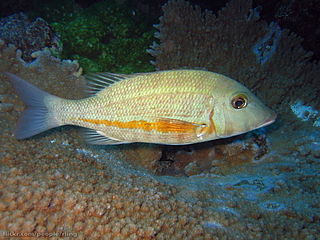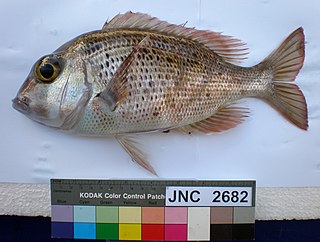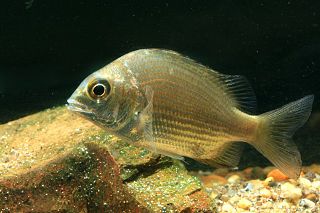
Lethrinidae are a family of ray-finned fishes belonging to the order Spariformes commonly known as emperors, emperor breams, and pigface breams.

Argyrops spinifer, the king soldierbream, Bowen snapper, long-spined red bream, longfin snapper, longspine seabream and red bokako, It is a species of marine ray-finned fish belonging to the family Sparidae. This species is found in the Indian Ocean.

Gymnocranius audleyi, the collared large-eye bream, collar bream, bastard bream, coral bream, iodine bream, pale-faced bream or sand snapper, is a species of marine ray-finned fish belonging to the family Lethrinidae, the emperors and emperor breams. This species is found in the Western Pacific Ocean.

Monotaxis is a small genus of marine ray-finned fishes belonging to the family Lethrinidae, the emperors and emperor breams. The fishes in this genus are found in the Indian and western Pacific Oceans.

Gnathodentex is a genus of marine ray-finned fish belonging to the family Lethrinidae, the emperors or emperor breams. It is a monotypic genus, containing a single species, the goldspot seabream, also known as the striped large-eye bream. This taxon has a wide distribution in Indo-West Pacific region.

Gymnocranius is a genus of marine ray-finned fishes belonging to the family Lethrinidae, the emperors and emperor breams. These fishes are found in the Indian Ocean and the western Pacific Ocean.

Lethrinus is a genus of marine ray-finned fishes belonging to the family Lethrinidae, the emperors and emperor breams. These fishes are mostly found in the Indian and western Pacific Oceans, with a single species in the eastern Atlantic Ocean.
Wattsia is a monospecific genus of marine ray-finned fish belonging to the familyLethrinidae, the emperors and emperor breams. The only species in the genus is Wattsa mossambica, the Mozambique large-eye bream or Mozambique sea bream of the Indian and Western Pacific Oceans.

Lethrinus olivaceus, common name longface emperor or long-nosed emperor, is a species of marine ray-finned fish belonging to the family Lethrinidae, the emperors or emperor breams. This species has a wide Indo-Pacific distribution.

Lethrinus obsoletus, the orange-striped emperor, yellow-banded emperor or yellowstripe emperor, is a species of marine ray-finned fish belonging to the family Lethrinidae, the emperors or emperor breams. This species has a wide Indo-Pacific distribution.

Lethrinus harak, the thumbprint emperorblackblotch emperor or blackspot emperor, is a species of marine ray-finned fish belonging to the Family Lethrinidae. the emperors and emperor breams. This species is found in the Indo-Pacific region.

Rhabdosargus is a genus of ray-finned fish belonging to the family Sparidae, which includes the seabreams and porgies. These fishes are found in the southeastern Atlantic Ocean and throughout the Indo-West Pacific, although mainly in the western Indian Ocean.

Gymnocranius griseus, the grey large-eye bream, barred large-eye bream, grey emperor, grey seabream and naked-head seabream, is a species of marine ray-finned fish belonging to the family Lethrinidae, the emperors and emperor breams. This species is found in the Indian and Pacific Oceans.

Gymnocranius grandoculis, the blue-lined large-eye bream, iodine bream, Maori sea bream or Robinson's sea bream, is a species of marine ray-finned fish belonging to the family Lethrinidae, the emeprors and emperor breams. This fish has a wide Indo-Pacific distribution.

Lethrinus crocineus, the yellowtail emperor, is a species of marine ray-finned fish belonging to the family Lethrinidae, the emperors and emperor breams. This fish is found in the Indian Ocean.

Lethrinus variegatus, the slender emperor or variegated emperor, is a species of marine ray-finned fish belonging to the family Lethrinidae, the emperors and emperor breams. This fish has a wide Indo-Pacific distribution.

Acanthopagrus bifasciatus, the twobar seabream, is a species of marine ray-finned fish belonging to the family Sparidae, the sea breams and porgies. This species is found in the northwestern Indian Ocean.

Monotaxis heterodon, the redfin emperor, is a species of marine ray-finned fish belonging to the family Lethrinidae, the emperors and emperor breams. This fish is found in the Indian and Western Pacific Oceans.

Lethrinus amboinensis, the Ambon emperor, is a species of marine ray-finned fish belonging to the family Lethrinidae, the emperors and emperor breams. This species is found in the Western Pacific Ocean.

Lethrinus borbonicus, the snubnose emperor, is a species of marine ray-finned fish belonging to the family Lethrinidae, the emperor breams and emperors. This species is found in the Western Indian Ocean and is of some importance to commercial fisheries in that region.



















